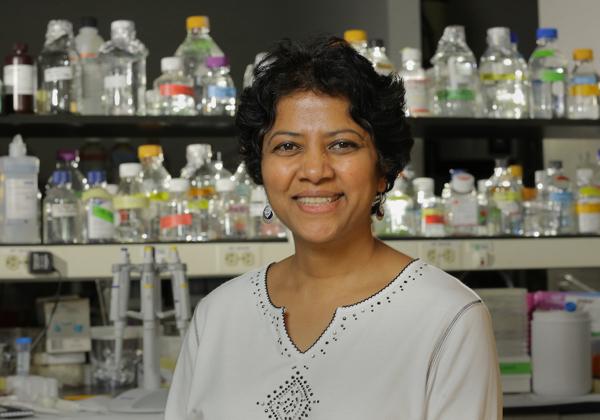
In 2016, the Duke School of Medicine selected 38 of its faculty for the new Duke Health Scholars and Duke Health Fellows Program. With funds from the Duke University Health System, the program supports the research efforts of early to mid-career clinician-scientists at Duke. Among the faculty honored are 14 individuals from the Department of Medicine, including Gowthami Arepally, MD, associate professor of medicine in the Division of Hematology.
When Dr. Arepally started a research rotation during her medical residency at Emory University, she expected to soak up some basic science and then get back to becoming a clinician.
But the puzzles the young doctor encountered at a bench there were too engaging—and too important—to turn away from.
Instead, Arepally decided to merge the experimental with the clinical, and since then one domain has deepened the other. “It’s that back and forth that is so gratifying,” said Arepally.
From the start, Arepally’s research has probed molecular steps that produce heparin-induced thrombocytopenia (HIT).
I was mesmerized by the cells. The cells were so awful in terms of disease potential, but so beautiful to look at. I wondered how such beautiful cells could be so deadly.
Gow Arepally, MD
Arepally’s insights into just how HIT happens have opened doors to better detecting and preventing HIT. “Gow’s scientific contributions to the field of HIT biology have been transformative,” said Michael D. Gunn, MD, chair of the Department’s Research Development Council.
And more weighty contributions may follow. Recent studies in the Arepally Lab have decoded very early immune system triggers from heparin in blood that may be a roadmap to other drugs triggering allergy-like immune attacks.
Parents pave a path
From watching how much her obstetrician mother and rehabilitation specialist physician father enjoyed their jobs, Arepally always wanted to be a doctor. She carried her plan to the United States when, at age 9, her family moved here from India. And she sustained it through four years at Mercer University and then medical studies at Vanderbilt University.
Hematology first seized her attention during residency at Emory University, partly because of expanding understanding of and successful treatments for blood cancers. Peering at abnormal blood cells with microscopes always reminded Arepally, however, that work remained to be done.
“I was mesmerized by the cells. The cells were so awful in terms of disease potential, but so beautiful to look at. I wondered how such beautiful cells could be so deadly,” Arepally said.
Arepally dug deep into basic science first at the University of Pennsylvania during a research fellowship. She analyzed the antibodies that stream toward platelets after doses of heparin alters a specific protein, platelet factor 4 (PF4), on their cell surfaces in the bloodstream. Linking drug to protein, it’s now known, alters the physical orientation of PF4 enough to make it look like an invader to some immune system scouts.
Arepally was the first to engineer a monoclonal antibody to PF4 and heparin, which is now patented and licensed to a biotechnology company to help diagnose HIT. Her research team was also first to create a mouse model for HIT (since improved), that uses copies of the engineered antibodies to create thrombosis and thrombocytopenia in lab animals.
All that helps her tell her patients why HIT must be treated. “When we see patients with this awful disease we can now say: We know why this is happening. We can model it in mice,” Arepally said.
The Arepally lab has plumbed antibody activation of platelets, which activates risky clumping and clotting. Lab members also have articulated immunogenicity of heparin-like molecules, pointing the way to a FDA standard for screening the molecular weights of drugs to try to reduce their immunogenicity.
Arepally’s team is working on tools to better predict which cardiac surgery patients are more likely to develop mischief-making antibodies in their bloodstream. They have identified a molecular pathway active even before antibodies get produced. This upstream pathway, which involves B-cells and a complement immune response, is what lights the fuse for the antibody assault that follows. Arepally’s studies have identified certain qualities, electrical charge and structural profile among them, that increase the chances of immune attacks.
“This is what all scientists live for: making progress in one disease and hoping the knowledge you gain is applicable to a broader audience,” she said.
The series of profiles of our Duke Health Scholars were written by Catherine Clabby, freelance science journalist. Photos are by Ted Richardson.